Racism

I stepped off the elevator and was greeted by three men with hoodies in church yesterday. My shoulders tensed for a few moments. Growing up in New York City, I’ve been groomed in paranoia and 20/20 peripheral eyesight. Yet after taking a second look, I smiled as I admired the theater props: Three hooded figures containing the faces of Hillary Clinton, Jay Z, and Trayvon Martin, with a caption reading, “We are Trayvon Martin.”
Metro Hope Church meets weekly at Harlem’s National Black Theater, so our church gatherings can often be a dance in improvisation as we’re frequently welcomed by new sets. One summer we were greeted by a gigantic “tree” protruding from center stage. It made this preacher’s imagination run vivid with all sorts of sermon possibilities.
But the hooded figures that greeted me last Sunday were a tribute to Trayvon Martin called, Facing our Truth: 10 Minute Plays on Race and Privilege. This month also happens to be the month that Trayvon Martin was born, and a month for celebration of Black History. These convergences do not escape me, nor does the distinct mission of our church in Harlem.
No stranger to dialogue on race and privilege, our church will often reflect on Dr. King who once lamented, “We must face the fact that in America, the church is still the most segregated major institution in America … 11:00 on Sunday morning …we stand at the most segregated hour in this nation.”
Indigenous American leaders speak out against the Washington NFL team’s mascot.

As I stated yesterday, I believe that America’s justice system is broken and in need of desperate repair. One of those areas is the practice of putting our citizens to death, something I believe that all Jesus People should resoundingly oppose.
When I was a conservative evangelical, I was a huge supporter of capital punishment for all of the standard reasons. I even had a quick response when folks correctly brought up the hypocrisy of being against abortion while simultaneously being pro-death penalty, a position I previously argued you can’t hold and still call yourself “pro-life.”
However, when I decided to follow Jesus instead of simply being a Christian who paid him hollow worship while conveniently ignoring the red words, I was forced to abandon my support of the death penalty (and abandon my support of violence in general) as part of Following Jesus 101.
While America’s broken justice system is a complex issue, perhaps the first area we can fix is by abolishing the death penalty in all 50 states. Here’s why I think Jesus People should be leading the charge on this issue:
WHEN MOST PEOPLE remember George McGovern, the longtime South Dakota senator who passed away in 2012, they probably don’t think first of his evangelical Christian background or see him as a model for evangelicals today.
But McGovern, the Democratic nominee who ran against President Richard Nixon in 1972, actually serves as a worthy exemplar of evangelically rooted social action.
The source of McGovern’s progressive and moral political views may be surprising to some. He was a son of the evangelical church. His father, Rev. Joseph McGovern, was an ordained minister of the Wesleyan Methodist Church (now the Wesleyan Church). It was founded in 1843 as a protest movement against the larger Methodist Episcopal Church. Simply put, they thought slavery sinful and left the denomination to make clear their moral opposition to the “peculiar institution.”
George McGovern enjoyed a good relationship with his father. His childhood was shaped by the rhythms of church life—three or four services on Sunday, prayer meeting on Wednesday night, and daily prayer and Bible readings. The annual family vacation was a two-week campout at nearby Mitchell Holiness Campground. Revival services were conducted nightly.
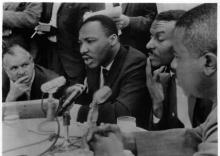
The nation will mark the birthday of the Rev. Martin Luther King Jr. on Monday with speeches, prayers, and volunteer service.
But for decades, retired United Methodist Bishop Woodie W. White has marked the holiday in a more personal way: He writes a “birthday letter” to the civil rights leader who was killed in 1968.
“It was a way to get kind of a year’s assessment on what the nation was accomplishing and not accomplishing in the area of race,” said White, a bishop-in-residence at Emory University’s Candler School of Theology for the last decade.
“I did it because, frankly, I needed to have perspective. I needed to not get discouraged, and I needed it to be affirming of progress in race which had taken place over the course of a year.”

I'VE NEVER FELT as powerful and proud of my community as I was while walking down the middle of Franklin Avenue in Minneapolis on a cold evening in November with hundreds of other Native activists and allies. We were marching from the heart of the Minneapolis American Indian community to the Hubert H. Humphrey Metrodome to speak out against the Washington Redsk*ns mascot.
Hundreds of American Indians and allies rallied outside the Metrodome to demand that Dan Snyder, owner of the Washington professional football team, change the team’s name and mascot in spite of Snyder’s dissent. The owner’s unwavering commitment to keeping the Redsk*ns name became evident when earlier this year he stated, “We’ll never change the name. It’s simple. NEVER. You can use caps.”
Standing among supporters and friends, I looked on as the community joined together in drumming, dancing, and singing, with American Indian Movement co-founder Clyde Bellecourt serving as the rally’s emcee. Several local elected leaders addressed the crowd, including U.S. Rep. Betty McCollum, co-chair of the Congressional Native American Caucus, and the mayor-elect of Minneapolis, Betsy Hodges, days after winning her election for mayor. The two joined an avalanche of elected leaders calling on Snyder and NFL Commissioner Roger Goodell to change the team’s name.
More than 20 years prior, another protest had been held at the Metrodome for Super Bowl XXVI, a game between the Washington Redsk*ns and the Buffalo Bills. That protest included Clyde Bellecourt’s brother, Vernon, leading the charge with Sen. Paul Wellstone, a friend and champion of the American Indian community. Two decades later, the conversation has changed and momentum is on our side. Even President Barack Obama joined the cause in saying, “I’ve got to say, if I were the owner of the team and I knew that there was a name of my team—even if it had a storied history—that was offending a sizeable group of people, I’d think about changing it.”

DOMINIC WAS 17 years old when the incident occurred. Dressed and ready to go to church, he walked out of his home in the Bronx just a few minutes ahead of his parents. All of a sudden, undercover police officers came out of nowhere, grabbed him, and threw him to the ground. As his parents came outside and discovered this scene, fear gripped them as they screamed to the officers, “What are you doing to my son?” “He fits the description. You stay out of this!” the officers replied. His mother pleaded, “Sir, he hasn’t done anything. He has been with us the whole time.”
While legal and political measures are being undertaken by opposing factions for and against the stop, question, and frisk practices of the New York Police Department, the debate rages. The fact remains, no matter what side you are on, considerable damage has already been done to a generation of African Americans and Latinos (particularly youth), not only in New York City but in other cities that have adopted this model of policing.
According to a recent analysis by the New York Civil Liberties Union, in 2012 “New Yorkers were stopped by the police 532,911 times. 473,644 were innocent (89 percent).” This means that out of more than half a million who were stopped, only 59,267 people were charged with any sort of illegal activity. In addition, 284,229 (55 percent) were African American and 165,140 were Latino (32 percent), most of them law-abiding citizens who were targeted, stopped, questioned, frisked, and found innocent. What is further troublesome is that not all actions conducted by officers were documented, so the actual number of those impacted negatively is even higher.
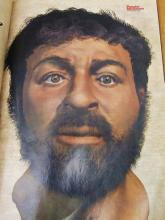
Conservative talk show host Megyn Kelly claimed on her Fox News show last week that “For all you kids watching at home, Santa just is white ... just because it makes you feel uncomfortable doesn’t mean it has to change, you know, I mean, Jesus was a white man, too ... that’s a verifiable fact, I just want kids to know that.”
This statement was in response to a Slate piece by Aisha Harris, “Santa Should Not Be a White Man Anymore,” which notes her confusion between seeing a black Santa figurine in her home while white Santas were popularized elsewhere at the mall and her school. Because the real history of St. Nicholas is so far removed from his present iteration as Santa Claus, she argues that it would be easier and less culturally problematic to change him into a penguin. This avoids questions of race and culture and makes him accessible to all. While I see her point about wanting to avoid cultural problems, it might be a good idea to confront the underlying issue of racism in America rather than continue to ignore it.
THE DOMINANT cultures of North America have long struggled to take responsibility for the suffering and injustice inflicted upon the Indigenous Peoples of the continent. The archetypal “us/them” story of cowboys and Indians remains at the core of North American national identities, from derogatory sports mascots and symbols such as the Washington “Redskins” and the “Chief Wahoo” character of the Cleveland Indians to the ignorant “redfacing” by non-Indigenous partygoers and trick-or-treaters in contrived Indian outfits. And this situation is nowhere near ending, despite many years of cultural sensitivity training and education.
Such overt racism should never be acceptable today. Yet it persists in regard to Indigenous Peoples. Why is this? As one friend remarked to me, most modern-day Americans believe injustices done to Indigenous Peoples to be a thing of the past.
But are they? Steve Heinrichs, director of Indigenous relations for the Mennonite Church in Canada, has brought together nearly 40 theologians, activists, writers, and poets—half of whom are Indigenous—to create Buffalo Shout, Salmon Cry: Conversations on Creation, Land Justice, and Life Together, a challenging anthology on Indigenous-Christian relations, stolen land, racism, and the impending environmental crisis that we all must face together.
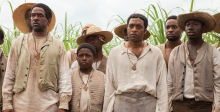
IN OCTOBER, Sojourners hosted a Washington, D.C. premiere for the faith community of the extraordinary film 12 Years a Slave. The compelling story about Solomon Northup—a free man from New York who was kidnapped and sold into slavery—is an accurate and well-produced drama, worth seeing for its cinematic merits, but primarily as a start to a conversation about race in America that is long overdue.
In her New York Times review titled “The Blood and Tears, Not the Magnolias,” Manohla Dargis wrote that 12 Years a Slave “isn’t the first movie about slavery in the United States—but it may be the one that finally makes it impossible for American cinema to continue to sell the ugly lies it’s been hawking for more than a century.” The film reveals how morally outrageous the slave system was, and it is very hard to watch.
The enslavement of millions of people of African descent by white Americans was always violent, and too intense for most white people to really accept the truth. Most white people, white Christians, and white churches tolerated slavery for 246 years. This historically horrendous evil existed because we tolerated it. That’s why evil always continues to exist: because we tolerate it.
What do we tolerate today? We tolerated the gratuitous evil of slavery, and still tolerate the devaluing of black lives. We tolerate completely dysfunctional urban schools, but would we still do so if they were full of young white children? We tolerate a criminal justice system where the racial disparities between white and black arrests, convictions, and sentencing are abundantly clear, resulting in the mass incarceration of men of color. We tolerate murder rates for people of color that we would never tolerate for whites. We tolerate racial profiling of young black men, with results that we would never accept for our white teenage boys. And we tolerate deliberate and clear political efforts to diminish the votes of minority communities.

On Sunday, with lots of turkey, stuffing and pie still in the fridge, I joined the #Fast4families movement, abstaining from food and drink for a day in order to pray for immigration reform. At first, I hesitated because it wasn’t necessarily my ideal time for fasting — besides being Thanksgiving weekend, I was about to enter the last two weeks of my academic semester, the most mentally demanding and sleep-depriving time of my year.
Quickly, however, I realized that all the worries I had going into the fast came from my white, privileged, experience of the world. Because of my privilege, I could believe in the illusion that immigration reform does not affect me.
The more I thought about this, the more I concluded that my reasons for not fasting were pointing to the ugliness of my own privilege and participation in racism, for if we do not actively challenge racism, we affirm it. This is what Jesus was getting at in Matthew 12:30, when he said, “Whoever is not with me is against me, and whoever does not gather with me scatters.” Jesus does not call us to merely advocate, but asks us invest our whole lives.
My hesitancy to fast was also a reflection of Western spirituality, which privileges the mind over the body and knowledge over action. Before I knew about the fast, my inclination was to spend my day’s energy on academic work, ignoring the body I live in, as well as those bodies that suffer far more than I ever would under an oppressive immigration system.
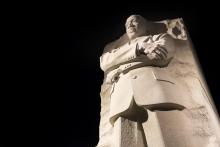
I must use the adverb “almost” because there is a necessary distinction between all and some. It is the difference between mighty and almighty.
But we must never forget that whatever is mighty can harness the power to destroy lives, families, communities, institutions, and nations. This is what racism does on a daily basis.
We have, to some degree, lost the will and/or the capacity to identify and challenge this destructive and powerful force in our culture and institutions.
This Advent season presents the church with a great moment — an opportunity — to sharpen its discernment. It is an opportunity for the church and the world to experience a new birth in love, racial justice, and reconciliation.

(Editors’ Note: Sojourners is running an ad in Rep. King’s district. Watch the ad and click here to learn more about it.)
Business leaders, law enforcement officials, and evangelical Christians—key constituencies that are typically part of the Republican base—have been at the forefront of immigration reform. Given the obvious benefits of, and broad public support for, immigration reform, why are many arch-conservatives in the House of Representatives refusing to address the issue in a serious way? The answer may point to an issue that we still hesitate to talk about directly: race.
Fixing our broken immigration system would grow our economy and reduce the deficit. It would establish a workable visa system that ensures enough workers with “status” to meet employers’ demands. It would end the painful practice of tearing families and communities apart through deportations and bring parents and children out of the shadows of danger and exploitation. And it would allow undocumented immigrants—some of whom even have children serving in the U.S. military—to have not “amnesty,” but a rigorous pathway toward earned citizenship that starts at the end of the line of applicants. Again, why is there such strident opposition when the vast majority of the country is now in favor of reform?
When I asked a Republican senator this question, he was surprisingly honest: “Fear,” he said. Fear of an American future that looks different from the present.

Before I saw the new film 12 Years A Slave, I knew nothing about Solomon Northrop or his astounding story of courage, forbearance, and faith.
I’d never heard of Northrop, an African-American freeman, who was born and reared in upstate New York in the early 1800s, well before the abolition of slavery in the rest of the nation. I’d not known of the historical practice of kidnapping freeborn black Americans in the North and selling them into slavery in the South.
I’d never heard about how Northrop, an accomplished violinist, was bamboozled into traveling from his farm in Hebron, N.Y., where he lived a prosperous life with his wife and three children, to Washington, D.C., for work, but was drugged, kidnapped, and sold in Louisiana. I’d never heard how he remained for a dozen years before heroically regaining his freedom in 1853 — one of a very few kidnapped freemen and freewomen ever to regain their freedom.
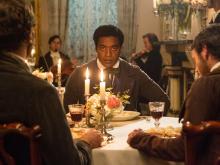
The most controversial sentence I ever wrote, considering the response to it, was not about abortion, marriage equality, the wars in Vietnam or Iraq, elections, or anything to do with national or church politics. It was a statement about the founding of the United States of America. Here’s the sentence:
"The United States of America was established as a white society, founded upon the near genocide of another race and then the enslavement of yet another."
The comments were overwhelming, with many calling the statement outrageous and some calling it courageous. But it was neither. The sentence was simply a historical statement of the facts. It was the first sentence of a Sojourners magazine cover article, published 26 years ago titled “America’s Original Sin: The Legacy of White Racism.”
An extraordinary new film called 12 Years a Slave has just come out, and Sojourners hosted the premiere for the faith community on Oct. 9 in Washington, D.C. Rev. Otis Moss III was on the panel afterward that reflected on the film. Dr. Moss is not only a dynamic pastor and preacher in Chicago, but he is also a teacher of cinematography who put this compelling story about Solomon Northup — a freeman from New York, who was kidnapped and sold into slavery — into the historical context of all the American films ever done on slavery. 12 Years is the most accurate and best produced drama of slavery ever done, says Moss.
In her New York Times review, “ The Blood and Tears, Not the Magnolias,” Manohla Dargis says, 12 Years a Slave “isn’t the first movie about slavery in the United States — but it may be the one that finally makes it impossible for American cinema to continue to sell the ugly lies it’s been hawking for more than a century.” Instead of the Hollywood portrayal of beautiful plantations, benevolent masters, and simple happy slaves, it shows the utterly brutal violence of a systematic attempt to dehumanize an entire race of people — for economic greed. It reveals how morally outrageous the slave system was, and it is very hard to watch.
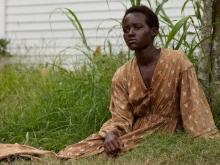
When we consider the typical church worship service in the United States, we discover certain trends. Lament and stories of suffering are conspicuously absent. In Hurting with God, Glenn Pemberton notes that laments constitute 40 percent of the Psalms, but in the hymnal for the Churches of Christ, laments make up 13 percent, the Presbyterian hymnal 19 percent, and the Baptist hymnal 13 percent.
Christian Copyright Licensing International (CCLI) licenses local churches for the use of contemporary worship songs. CCLI tracks the songs that are employed by local churches, and its list of the top 100 worship songs as of August 2012 reveals that only five of the songs would qualify as a lament. Most of the songs reflect themes of celebratory praise: “Here I Am to Worship,” “Happy Day,” “Indescribable,” “Friend of God,” “Glorious Day,” “Marvelous Light,” and “Victory in Jesus.”
How we worship reveals what we prioritize. The American church avoids lament. Consequently the underlying narrative of suffering that requires lament is lost in lieu of a triumphalistic, victorious narrative. We forget the necessity of lament over suffering and pain. Absence doesn’t make the heart grow fonder. Absence makes the heart forget. The absence of lament in the liturgy of the American church results in the loss of memory.
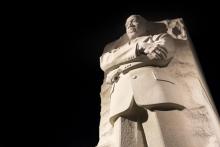
Are we waiting for another Dr. King? As I collect my thoughts to write these words, I’m mindful that I don’t honestly know what discrimination is. I have never (consciously) experienced discrimination because of my race, the color of my skin, or where I come from. I have never had to say, like Solomon Northup, “I don’t want to hear any more noise.” In the film, 12 Years a Slave, Solomon refers to the cry of those being beaten and separated from their children. I speak here with a profound sense of respect and fear. Who am I, or maybe even you who read, to speak about a tragedy and a pain that we have never experienced? I only speak out of a sense of duty and a calling from God.
Dr. King wrote, “So many of our forebears used to sing about freedom. And they dreamed of the day that they would be able to get out of the bosom of slavery, the long night of injustice … but so many died without having the dream fulfilled.” (A Knock at Midnight, p.194)
To this day, millions of African Americans in our country still dream about getting out of the bosom of slavery. Slavery today is masked behind the social, financial, political, and even religious systems that deny the dignity and full integration into these systems to people of color. Solomon Northup cries out in the film saying, “I don’t want to survive, I want to live.” The struggle of African Americans is a struggle to live. So far, they have only survived.
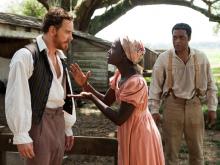
Crickets chirping, a branch creaks, and a black body swings on a tree whose roots grow deep into a shared story of our American past. These are images that are floating in my mind, after watching a pre-screening of12 Years a Slave. This film was a terribly beautiful depiction of the antebellum south and the atrocity known as slavery. Its honesty was riveting, as the film portrays characters in ways never captured before on the big screen. They were characters such as Mistress Shaw (played by Alfre Woodard), the black wife of a slave master who is adored by her husband and treated as a white woman. In a panel discussion, Lisa Sharon Harper of Sojourners asked Woodard, about this character. And she responded that in the South, there were all kinds of arrangements between whites and blacks. Her character Mistress Shaw learned how to survive. I was so refreshed that 12 Years a Slave, was a new depiction of slavery instead of a rehashing of Roots orAmistad.
The panel also consisted of a plethora well-informed faith leaders. One of the panelists, Jim Wallis, while discussing the aspects of faith profoundly said, “Enslaved Africans saved Christ from the Christians.” I was immediately struck by his words as they reminded me of how I became a Christian.

Strange but beautiful things happen when we begin to identify with people who are culturally different. A few years ago, I became friends with Peter, a guy at my church who also happened to be an undocumented immigrant. One day over lunch, he shared that his mother (whom he hadn’t seen in 15+ years) had recently been diagnosed with a terminal disease. He desperately wanted to visit her, but due to his immigration status, he knew that if he left the U.S. he wouldn’t be allowed to return. Given his obligations to his family in the U.S., Peter made the heart-breaking decision to not to visit his dying mom.
As a U.S. citizen, I hadn’t personally experienced the trials of being undocumented or felt the frustration of geographic immobility while a loved one approached death in a far off land. But throughout my friendship with Peter — getting to know his family in the U.S., listening to him share about the harrowing challenges he experienced on a daily basis, and seeing photographs of his life and family in his home country — I got a glimpse of the world from his perspective. In many ways, Peter’s life was marked by sorrow and loss – and that was more evident than ever during our lunch conversation that day.

I pre-screened 12 Years a Slave the same weekend I saw Gravity. The two films couldn’t be more different, although they do have some fascinating (if not immediately obvious) commonalities.
As for commonalities, they’re both powerful and both deserve to be seen. Both are about people trying to get home — one, in a harrowing adventure that takes several hours, the other in an agonizing 12-year struggle. The protagonists of both movies demonstrate heroic resilience and courage. One struggles with physical weightlessness, the other with a kind of social or political weightlessness.
Although Gravity impressed and fascinated me, 12 Years a Slave affected me and shook me up. Now, several days later, scenes from the film keep sneaking up on me and replaying in my imagination — three in particular.